St Albans, Hertfordshire
Up to 1834
St Albans (often apostrophised as St Alban's in historical documents) had a workhouse from the early 1700s. A report dated September 1724 from St Albans in An Account of Several Workhouses... recorded that:
Flax is bought at 6d. per Pound prepared for spinning ; and 8 Pound, when spun up, will serve to make a Pair of Sheets.
The Wool is furnish'd by a Clothier, ready prepar'd for spinning into Jersey, who gives from 7 d. to 14 d. a Pound for spinning it, according to the Fineness of it.
The Wheels are provided at the Publick Charge, but then with Care they last many Years, so that there has been no Occasion to buy any since opening the House 1720, when two dozen were provided at 2 s. 6 d. each.
The House is an old Building, partly Brick, and partly Plaister, well repair'd for the purpose, and will accommodate 100 People : There is an Acre and an half of Ground belonging to it, and the whole cost the Town about 250 l. out of which they lett as much to a Gardener as yields 10 l. per Annum.
As for Furniture, the poor People generally bring in their Bedding, and some other small Necessaries, of which an Inventory is taken when they are brought to the House, so that there has been no Occasion to buy more than three Beds, and a few other Things.
70 Yards of Cloth, at 2 s. per Yard, has, with the Assistance of a Taylor, served to make and mend what was necessary of wearing Apparel, for 4 Years past, joined with the old Cloaths brought to the house by the Poor.
As to Linnen, we spin all we have Occasion for, and buy the Flax at the Rate abovementioned.
But that you may be more perfectly acquainted with the Expence of our Management, it is necessary that I give you some Account of our Kitchen Provision, either Weekly, Monthly, or Yearly, by which you may estimate the whole.
BEEF, 72 Pound Weight, at 2 d. ½ per Pound, or 20 d. per Stone, serves the House one Week. If we don't lay in so much Beef, for Variety, we make up the Weight mention'd with Mutton, Pork, or Veal, at the same Price, when they are in Season.
FLOUR, 2 Bushels at 4 s. per Bushel, serves a Week for Bread and Puddings.
MILK, 7 Gallons at 4 d. per Gallon, serves a Week.
BUTTER, half a Firkin, containing about 40l. at 4 d. per Pound, serves us two Months.
CHEESE, three hundred Weight of Cheshire and Glocestershire, at 3 d. per Pound, serves us two Months.
As to Beer, we buy so good at 5 s. per Barrel, 36 Gallons to the barrel, that we think we should not save much by brewing it, all things considered; and 1 ½ Barrel serves one Week.
The Poor have 4 Flesh-Days in each Week, and in other respects fare as other Houses of this kind.
If any are sick, they are well nursed, and taken Care of by the Women of the House, in an Apartment for that purpose ; and to super-intend all, we have a discreet Man and his Wife, who, for 15 l. per Annum, and an Apartment in the House, with the Kitchen Fare, take Care of every Thing : The Man keeps the Accounts of the House, both of what comes in, and what goes out, or is expended, in a Method prescribed by the Overseers.
The good Effects of our Management is apparent from the Reduction of our Rates for the Poor ... we have, in about four Years Time, reduc'd our Poor's Rates above half, and hope to save more hereafter, now our House, and other extraordinary Charges are paid for.
Before this Management, it cost us at least 30 l. per Annum for House-Rent, and 15 or 20 1. per Annum to an Apothecary for Medicines; both which Articles are now entirely saved.
A report for the St Albans parish of St Stephen's from March, 1725, observed that:
Eden, in his 1797 survey of the poor in England, reported of St Albans that:
The St Albans parish of St. Peter's had its parish workhouse on St Peter's Street. In 1776, it could accommodate 70 inmates.The building is now used as business premises.
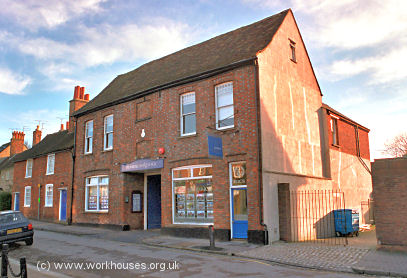
St Peter's parish workhouse.
© Peter Higginbotham
In 1820, the St Albans parish of St Michael had a parish workhouse opposite the east end of the church.
Harpenden established a workhouse in 1756, thought to be located at the east side of St Nicholas' churchyard in what were later referred to as Windows' Houses. In 1776 it had twenty inmates .
In Sandridge, a workhouse was built to the south-west of the church in the late 1770s.
In 1790, the parish of Redbourn, to the north-west of St Albans, rebuilt its parish workhouse at Church End. In 1832, it had an average of 25 inmates, said to be about one third each of 'children, casualties, and elderly persons'. The building was converted to cottages in the nineteenth century.
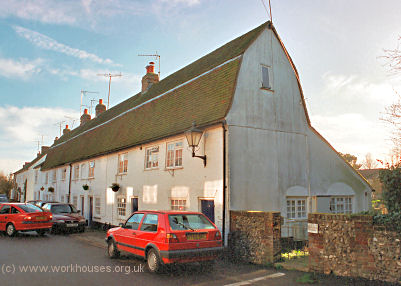
Redbourn parish workhouse.
© Peter Higginbotham
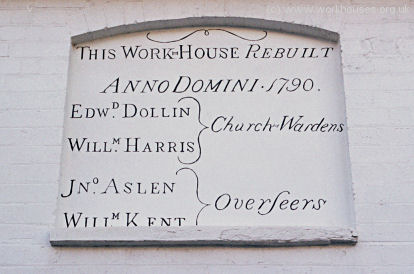
Redbourn parish workhouse.
© Peter Higginbotham
Wheathampstead had a workhouse by 1776, when it could accommodate 36 inmates. The building is thought to have stood on a site known locally as Workhouse Yard, at what is occupied by Bankside Chmabers, incorporating numbers 14 to 22 High Street.
In 1835, parish workhouses were in operation at Wheathampstead, Sandridge, Redbourn, Harpenden, and the St Albans parishes of Abbey, St Stephen's and St Peter's.
After 1834
St Albans Poor Law Union was formed on 23rd May 1835. Its operation was overseen by an elected Board of Guardians, 17 in number, representing its 8 constituent parishes as listed below (figures in brackets indicate numbers of Guardians if more than one):
County of Hertford: Redbourn (2), Sandridge, Harpenden (2), St Albans — Abbey (3), St Albans — St Michael (2), St Albans — St Peter (3), St Albans — St Stephen (2), Wheathampstead (2).
The population falling within the union at the 1831 census had been 15,833 with parishes ranging in size from Sandridge (population 810) to St Albans — Abbey (3,092). The average annual poor-rate expenditure for the period 1832-35 had been £8,488 or 10s.9d. per head of the population.
Initially, the union made use of old parish workhouses at Sandridge (for able-bodied paupers), Redbourn and St Stephen's. Wheathampstead, Harpenden, St Peter's and the Abbey were judged to be "quite insufficient and useless as workhouses for the Union" and were disposed of.
St Albans union workhouse was erected in 1836-7 on what is now Normandy Road (formerly Union Lane). It was designed by John Griffin who was also responsible for the workhouses at Hemel Hempstead and Barnet. An infirmary was later added to the south-east of the workhouse. A chapel was erected at the south of the site in 1893. The workhouse location and layout are shown on the 1897 map below.
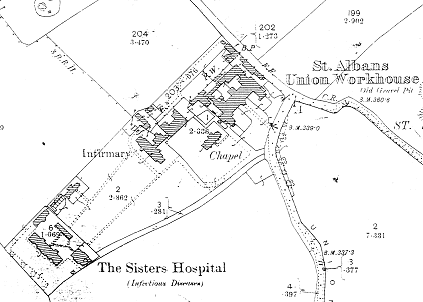
St Albans site, 1897.
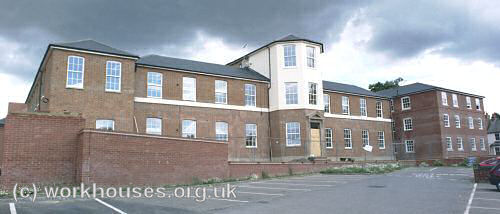
St Albans from the south, 2001.
© Peter Higginbotham.
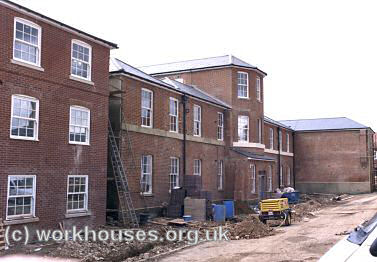
St Albans from the north, 2001.
© Peter Higginbotham.
In 1894, the British Medical Journal set up a "commission" to investigate conditions in provincial workhouses and their infirmaries. Following a visit to St Albans, the commission's report made a number of recommendations including: that the cramped infirmary be replaced; that a paid attendant be put on duty in the sick wards at night; and that separate wards be provided for the insane and for venereal cases. Further details are available in the full report.
Alan Hobbs recalls:
In 1930, the workhouse site was taken over by Hertfordshire County Council and became Oster House Public Assistance Institution, renamed Osterhills in 1946. Under the National Health Service in 1948, the original workhouse buildings became Waverley Lodge old people's home, while the medical facilities of the site became St Albans County Hospital. In 2001, the surviving buildings were redeveloped for residential use.
Cottage Home
In around 1911, the St Albans Union established a children's cottage home at Luton Road, Harpenden. The home, known as 'Harcourt', could accommodate 18 children. In 1930, it was taken over by Hertfordshire County Council but was closed in around 1932.
Staff
Inmates
Records
Note: many repositories impose a closure period of up to 100 years for records identifying individuals. Before travelling a long distance, always check that the records you want to consult will be available.
- Hertfordshire Archives and Local Studies, County Hall, Pegs Lane, Hertford SG13 8DE. Holdings include Guardians' minute books (1850-1930); Admission and discharge registers (1835-1952); Births (1871-1952); Deaths (1905-52); Creed registers (1911-52).
Bibliography
- Gutchen RM, Truwert E, and Peters G (1984) Down and Out in Hertfordshire — A Symposium on the Old and New Poor Law (Hertfordshire Publications)
- An Account of Several Work-houses for Employing and Maintaining the Poor. Anon, 1732.
Links
- Children of St Michael's Workhouse, St Albans by Jill Waterson (on the 'Hertfordshire' page).
- BMJ Report on St Albans Workhouse and Infirmary, 1894
Unless otherwise indicated, this page () is copyright Peter Higginbotham. Contents may not be reproduced without permission.


